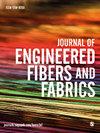可生物降解静电纺丝PHBV/PBAT/TiO2抗菌纳米纤维膜的制备与表征
IF 2.3
4区 工程技术
Q1 MATERIALS SCIENCE, TEXTILES
引用次数: 1
摘要
近年来,为了减少口罩、防护服等医用防护材料对环境的污染,可生物降解的抗菌材料越来越受到重视。本研究将聚(3-羟基丁酸酯-共-3-羟基戊酸酯)(PHBV)和聚(己二酸丁酯-共对苯二甲酸酯)(PBAT)电纺在一起,然后用纳米TiO2处理,开发并评价了一种可生物降解、抗菌的医用防护织物纳米纤维膜。SEM图像显示,质量分数为13、质量比为50:50PHBV/PBAT的纳米纤维膜在所有样品中具有最小的直径和最佳的形态。此外,力学性能测试和水接触角测试结果表明,与纯PHBV相比,PBAT/PHBV复合纳米纤维膜在不影响其基本结构的情况下具有更好的力学性能和疏水性。TiO2纳米颗粒的加入降低了这种纳米纤维膜的纤维直径。当TiO2浓度为1.0时 重量%,平均纤维直径为367 纳米,这可能接近亚微米水平。同时,TiO2的存在降低了PBAT/PHBV膜纤维之间的粘附性,导致纤维分布更加均匀。此外,PHBV/PBAT/TiO2纳米纤维膜的断裂伸长率为1.0 TiO2的重量百分比从(135 ± 5) %至(203 ± 2) %。含1.0的PHBV/PBAT/TiO2纳米纤维膜 wt%TiO2对大肠杆菌和金黄色葡萄球菌有抑制作用,抗菌率达98%以上。在这项研究中,我们成功地制备了可生物降解和抗菌的复合材料,可应用于医疗防护领域。它可以促进纺织防护材料朝着功能化和降解的方向发展。本文章由计算机程序翻译,如有差异,请以英文原文为准。
Preparation and characterization of biodegradable electrospinning PHBV/PBAT/TiO2 antibacterial nanofiber membranes
To reduce the environmental pollution caused by medical protective materials, such as masks and protective clothing, biodegradable antibacterial materials have received more and more attention in recent years. In this study, poly(3-hydroxybutyrate-co-3-hydroxyvalerate) (PHBV) and poly(butylene-adipate-co-terephthalate) (PBAT) were electrospun together and then treated with nano-TiO2 to develop and evaluate a biodegradable, antibacterial nanofiber membrane for medical protective fabric. The SEM images displayed that the nanofiber membrane with a mass fraction of 13 and a mass ratio of 50:50 PHBV/PBAT had the smallest diameter and the best morphology of all samples. In addition, the mechanical properties test and water contact angle test results demonstrated that the PBAT/PHBV composite nanofiber membrane had better mechanical properties and hydrophobicity without compromising its fundamental structure than pure PHBV. The addition of TiO2 nanoparticles decreased the fiber diameter of this nanofiber membrane. When the TiO2 concentration was 1.0 wt%, the average fiber diameter was 367 nm, which might approach the sub-micron level. Meanwhile, the presence of TiO2 reduced adhesion between fibers of the PBAT/PHBV membrane, resulting in a more uniform fiber distribution. Additionally, the elongation at the break of the PHBV/PBAT/TiO2 nanofiber membrane with 1.0 wt% TiO2 was raised from (135 ± 5)% to (203 ± 2)%. The PHBV/PBAT/TiO2 nanofiber membrane containing 1.0 wt% TiO2 inhibited Escherichia coli and Staphylococcus aureus, and its antibacterial rate was over 98%. In this research, we successfully prepared composite materials that were both biodegradable and antibacterial, which can be applied in the field of medical protection. It can promote the development of protective textile materials in the direction of functionalization and degradation.
求助全文
通过发布文献求助,成功后即可免费获取论文全文。
去求助
来源期刊

Journal of Engineered Fibers and Fabrics
工程技术-材料科学:纺织
CiteScore
5.00
自引率
6.90%
发文量
41
审稿时长
4 months
期刊介绍:
Journal of Engineered Fibers and Fabrics is a peer-reviewed, open access journal which aims to facilitate the rapid and wide dissemination of research in the engineering of textiles, clothing and fiber based structures.
 求助内容:
求助内容: 应助结果提醒方式:
应助结果提醒方式:


